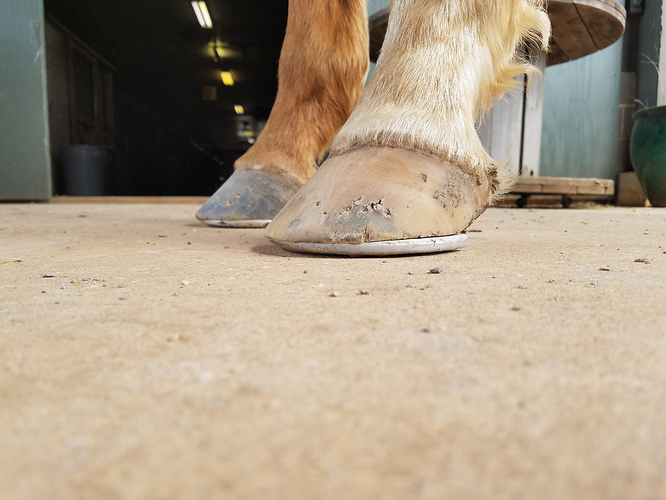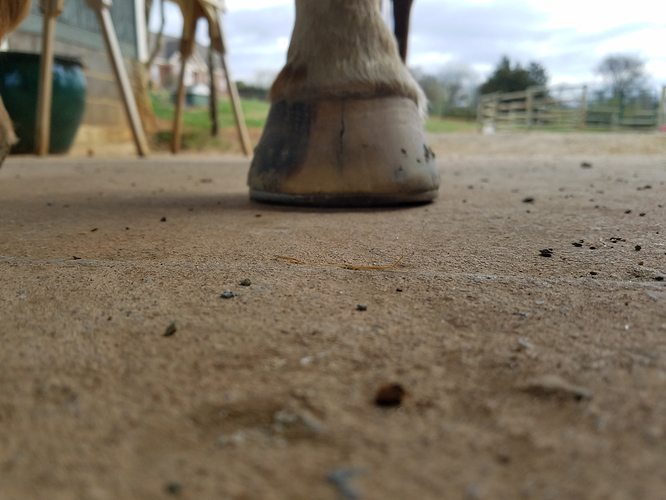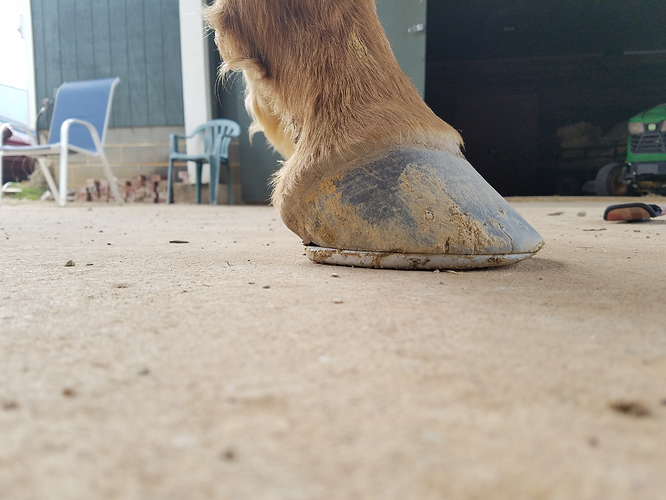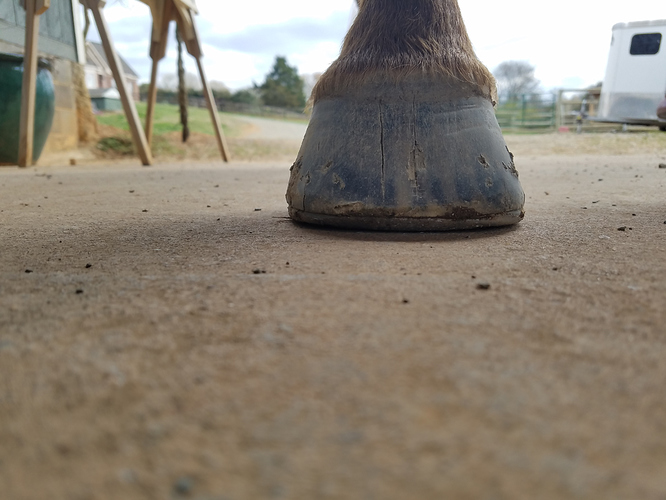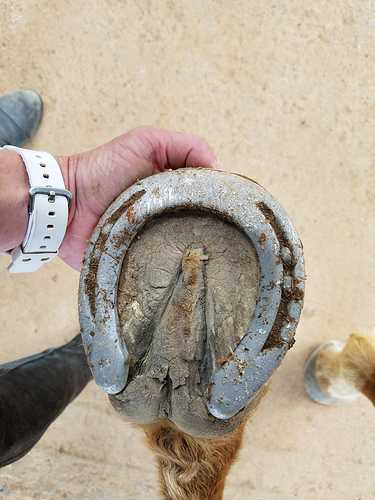OH THANKS!!! That is a great video! The resolution of the MRIs is pretty awesome…
This.
yep and if by “rebuilding” the heel they are not trimming/bringing the heels back, or wedging without trimming the heels right then all they do is fold under and crush, causing sore heels and toe first landings.
In 80%+ navicular horses there is always soft tissue damage before bony changes happen. Caused by toe first landing.
Pictures of the feet would be very useful.
I think this is a large part of the issue.
There’s a gal at a barn I teach at who has a mare with long toes and crushed, run-forward heels. The gal is aware of the issue and is taking good steps to fix them, but what she isn’t doing is RIDING HER. In her mind, she doesn’t want to stress the mare’s feet prematurely and wants to get them back in better shape before starting to ride again.
Problem there is that unless a horse is being asked, routinely, to carry themselves properly, they are highly unlikely to develop good landing posture on their own. The gal’s mare is out in the pasture moving around however she pleases - you know she’s not going to fix things on her own. The hoof is simply an extension of the leg - if the horse is using the body properly then light, correct riding only serves to rehab the feet faster. This gal is missing out on all kinds of positive impacts she could have on the mare’s hooves by choosing not to ride her.
Unfortunately, it sounds like the owner of this horse is maybe less aware/less knowledgeable and doesn’t have the skills (yet) to ride the horse correctly, in which case therapeutic/corrective shoeing is only going to go so far. I don’t have much in the way of advice as to how to plant seeds with the owner as I’m usually direct about these things, but certainly bringing to her attention the postural pieces that affect how the horse lands and thus affect how quickly his feet change (or don’t) for the better might help. Knowledge is power, after all.
@Abbie.S You are right on the nose, I think. This horse’s bodyworker had a scheduled appt with the horse today. She worked on my horse previously and is very anatomy-oriented and articulate. Since I held the horse for her, I told her about what I was seeing and feeling. She told me about what she’s been doing with the horse (I know the horse’s history from the owner) for the past year and she is well aware of the issues with this horse for the past year. She and I both think there is an underlying issue since the major shoeing issues were addressed. She mentioned it could be due to how he is ridden and I mentioned the owner’s way of riding (in a kind way). Or it could be due to years of bad shoeing and unhelpful riding stressing joints, tendons and/or ligaments. She looked at things more closely and the owner’s wife was there to take it all in. The bodyworker verified my thought that there is an underlying issue besides shoeing and suggested to the wife (who also rides) that a more extensive veterinary work-up is advised.
Tomorrow, our farrier is coming out to re-set a shoe for my horse and I’ll talk to him about what I’ve noticed with this horse. He thinks the owner was just complaining.
I plan to summarize all of this for the owner when he returns and help him develop a plan of action (which includes regular lessons -he doesn’t ride well). Oh. My. God. is the horse crazy crooked! Luckily, he is so willing and sensitive. But he’s only 8 and the owner totally loves him.
I don’t see thrush, and other people haven’t mentioned it either. This horse’s original farrier consulted with the horse’s original veterinarian’s radiographs (but didn’t like the angles) and they consulted with my vet after her radiographs and then the horse moved to my farrier recently. The horse has had attention to his feet in the last solid year. Radiographs showed no navicular changes although I’d vote for a MRI at this point. Or ultrasound.
I can try to take pictures, the horse is about 3 weeks through a 5 week cycle.
Pictures would be great! Bottoms of the feet as well so we can see the health of the frog 
MRI or ultrasound would be useful to see if there is any soft tissue damage to the DDFT or the navicular bursa, which is a precursor to a large number of navicular cases.
There are several steps that could be done before MRI. For one, new radiographs to assess how the shoeing changes are going, flexions all around, start blocking heels… etc. This would confirm if the issues are indeed within the foot and whether or not both feet.
If, for example, a PD block doesn’t do much, and you wind up getting a better result from a block higher up, then the standard MRI views for front feet aren’t going to go high enough–the vet would need to order something else on MRI. And perhaps there’s some ultrasound to be done first.
OK, this is a QH foot, 4 weeks into a 5 week schedule, roller front shoes with wide support for the hoof wall (I rained a ton here last week, things have just dried out):
It’s beyond the skillset of most novice horse owners to analyze gait on their own. They haven’t seen years worth of different horses’ way of going the way most of us have. So, make a short video in slo-mo where you’re zoomed in on this horse’s footfalls to clearly show the dysfunctional gait. Then show him a short video of normal horse gait-- this one is good so he can see the difference in hoof placement.
I would not tread so cautiously around this owner, or thread the needle. If he’s funding all of this diagnostic work, he seems willing to do the right thing by the horse. Most guys I know prefer a direct communication style. You don’t have to frame it as bad riding, he just needs to ride differently.
From a quick glance: That horse’s toes are too long to still have one more week in his shoeing schedule. Maybe he needs a 4 week schedule for a bit. Also, the white foot looks unbalanced medial/laterally.
How long has the farrier been doing this horse?
The flare is long-standing, as it goes all the way nearly to the top of the coronet - in the lateral view you can see the change in angle maybe 1/2" or so down. This means at least a full hoof growth cycle, so 9+ months, of too-long toes.
The heels are quite contracted with unhealth frogs, possibly some thrush in that crack in the LF. And no doubt these heels are sore, which means - toe-first landing.
Nobody will be able to ride this horse properly while his feet hurt, and his feet hurting will continue to make him use his body incorrectly the 23 hours a day he’s not in work.
The toes are too long, but also the whole hoof is overgrown and full of dead sole. Look at the depth of the collateral grooves, the pressure ridges in the bar material, the stress rings over the toe pillars, the cracks at the centre of the toe and at the toe pillars, the arched hairlines, and how far forward the frog has stretched. It looks like, for a long time, the farrier has only been removing wall that grows beyond the sole. The problem is that the sole is so overgrown and built up that it has now made the hoof unbalanced, especially A-P.
edited to add - the more correct breakover that is provided by the rolled shoe could have been achieved just by shortening the toe.
I hate picking apart a horse’s feet as farriers are often some of the most harshly critiqued professionals in the equine industry…but like JB and Postandrails, I don’t see a lot going on in those photos that is going to improve the horse’s foot.
I would expect to see less growth/change in a five week rotation at this time of year than, say, in August or September which tells me the initial trim and shoeing job is probably not working towards improving this horse’s issues. I did my gelding’s feet yesterday (he’s barefoot) and I didn’t even need to take the nippers out, just rasped, beveled and cleaned up his bars and frog (and I don’t even usually touch the frog if I can help it, but mud season plus shedding frogs around here equals potentially nasty infections).
How old is this horse? If you look at the direction his feet are growing, he’s growing out in a pretty classic forward direction instead of the tubules angled towards the ground. I would not be surprised in the least to find out he had a negative palmar angle in both feet. If he’s anywhere into his teens, it’s going to be a lot harder to change the way his feet want to grow without consistent correct riding. My 17yo gelding - the one I trimmed yesterday - is barefoot, has been for years, and his RF heels are still a bit contracted. It’s how he’s been for most of his life, so at this point there is little that correct trimming alone is going to be able to do to fix that. The real change has come from correct riding.
J-Lu said upthread that he’s only an 8 year old.
I see the same issues that have already been mentioned. Rockering the toe can help when you can’t take off any more toe without causing a heel-high posture or other problem and if you need to improve breakover. This horse has too much toe, and he’s flaring out over the shoes for it being only 4 weeks.
I think X-rays would be helpful. I agree he’s got what looks like a lot of dead sole and the heels are contracted some. It would be good to know how much total sole we’re working with. It would also tell you how bad the balance is.
Maybe he needs a frog support pad or something after a better trim. More frequent trims too most likely.
Thanks, everyone!!
Yes, this horse is only 8, coming 9 I think. He was started as a 2 year old for Western Pleasure but has been with this owner since he was almost 4, I believe.
@anon81364900, you are right. Luckily, his wife was very straightforward with him at dinner the other night so I didn’t have to be (I was shocked - he was on speaker phone with us). He came back into town last night and rode tonight when I happened to be there. I grabbed a beer and gave him a lesson. He is more open minded (just slightly!) now that he should change his riding but honestly, he doesn’t have the background to ride with finesse or balance the horse properly. But he tried and made some progress and at least said he felt the difference when the horse was moving forward and off the forehand.
Luckily, the vet comes out for spring shots on Friday and I gave her a heads up about this horse. The owner is now also buying into the idea that there may be an underlying issue. I have more flexible time than he does and I may hold his horse for much of the exam. I will at least be present to make sure the right questions are asked (owner is thankful). Same for the farrier next week. My horse gets sedated and I will likely hold his horse while mine wakes up, and can have a more nuanced discussion with my farrier. Everyone involved is interested in figuring out what the issue is.
This farrier has been doing this horse for 2 cycles. Next week will be his third time. The previous farrier had the horse in pads and then felt it was time to take the pads off. The old vet did radiographs and sole depth, which was thought to be thin. The old farrier wasn’t a fan of the angles and the owner switched to my vet, who shared her radiographs with the old farrier and they talked about approaches based on the x-rays. Sole depth was OK. Horse has been off for a little over a year and the old farrier said “I’m out of ideas, feel free to try someone else”.
The owner is a novice horse owner and I think thought “I changed something so my horse should be fine now”. I think he kind of skimped on addressing the issue directly. He’s coming to understand that horses can be more complicated and can cost money (he can afford it).
@JB , Yes, flares have been a problem for the last year (I never paid attention before that) and I think the toes were too long with the previous farrier. His front hooves usually flared into pancakes. BUT, the owner was not always great keeping the horse on a regular schedule before a year ago.
@No1 ,the white foot is the foot that has been more off for the last year. I don’t think my vet found anything with radiographs but consulted with the old farrier on how to trim based on the radiographs. I want to say that was 6 months ago. She noted that the front L was off. This horse was on a 4 week schedule with the previous farrier for a while.
ETA: My vet likes how my farrier shoes my horse. I’ve had this vet/farrier combo for 7-ish years now? The farrier is a sport horse farrier recommended to me by trainers I have worked with.
I can try to take pictures again after shoeing and post them.

